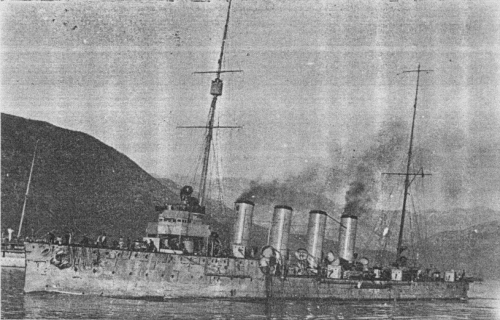
NAVYPEDIA
 Support the project with paypal
Support the project with paypal
Photo

Helgoland 1914 Many thanks to Wolfgang Stöhr for additional information on this page.
Ships
| Name | No | Yard No | Builder | Laid down | Launched | Comp | Fate |
|---|---|---|---|---|---|---|---|
| Saïda | 25 | CNT, Monfalcone | 9.9.1911 | 26.10.1912 | 1.8.1914 | to Italy 1920 (Venezia) | |
| Helgoland | 44 | Danubius, Fiume | 28.10.1911 | 23.11.1912 | 29.8.1914 | to Italy 1920 (Brindisi) | |
| Novara | 45 | Danubius, Fiume | 9.12.1912 | 15.2.1913 | 10.1.1915 | to France 1920 (Thionville) |
Technical data
| Displacement normal, t | 3500 |
|---|---|
| Displacement full, t | 4010 |
| Length, m | 129.7 wl 130.6 oa |
| Breadth, m | 12.8 |
| Draught, m | 5.30 deep load |
| No of shafts | 2 |
| Machinery | Saida: 2 Melms-Pfenniger steam turbines, 16 Yarrow boilers Helgoland, Novara: 2 AEG steam turbines, 16 Yarrow boilers |
| Power, h. p. | 30000 |
| Max speed, kts | 27 |
| Fuel, t | coal 771 |
| Endurance, nm(kts) | 1600(24) |
| Armour, mm | side: 60, deck: 20, shields: 40, CT: 50 |
| Armament | Saida: 9 x 1 - 100/47 G. L/50 K.11, 1 x 1 - 47/40 SFK L/44 S, 3 x 2 - 450 TT Helgoland, Novara: 9 x 1 - 100/47 G. L/50 K.11, 1 x 1 - 47/40 SFK L/44 S, 1 x 2 - 533 TT, 2 x 2 - 450 TT |
| Complement | 327 |
Graphics
Project history
The three 'modified Spaun' were approved in the same budget as the Tegetthoffs. Basically they had the same dimensions and displacement as Admiral Spaun, but with the rapid development of turbines 52t machinery weight could be saved by using a simpler 2-shaft arrangement. Of this 21t were used to strengthen the hull and the bulkheads, the remaining 21t being used to increase the armament. Of the two proposed alternatives (adding 1-15cm gun or 2-10cm), the second was chosen. The 'modified Spauns' therefore were a real improvement, enjoying reliable machinery and two more guns, although still being inferior in armament when compared with their contemporary opponents. As Fred T Jane stated in 1912, the period of the scout was over, and these units were very rapidly obsolescent. For reasons of equal distribution of armament contracts, two of them were to be built at the new Hungarian shipyard of Danubius at Fiume (Rijeka), while the name-ship was the first major warship built at the privately owned Cantiere Navale Triestino. In contrast to her Hungarian sisters she had a different type of turbine which gave her a slightly lower speed.
The three cruisers saw extensive wartime service, participating in several cruiser actions. Like their predecessor it was planned to up-gun them in 1917 by removing 3-10cm on the forecastle and 2-10cm on the quarterdeck and replacing them by 1-15cm/50 on the forecastle and another on the quarterdeck, but this was also never executed.
Ship protection
60mm belt protected machinery only, 20mm flat main deck was connected with its upper edge. 20mm lower deck protected ship ends. CT had 50mm sides. Gun shields had 40mm faces and 8mm sides and roofs.
Modernizations 9.
1915, Helgoland, Novara: - 2 x 2 - 450 TT; + 2 x 2 - 533 TT
1917, all: + 1 x 1 - 66/47 G. L/50 BAG
Naval service
In 1920 Saïda and Helgoland were ceded to the Italian Navy and commissioned as Venezia and Brindisi respectively. Both were discarded in March 1937. Novara was ceded to France in 1920, commissioned as Thionville and served as a gunnery and torpedo TS in the Mediterranean until 1932. She was then disarmed and served as a stationary accommodation ship at the naval arsenal of Toulon; in 1941 she was sold for scrapping.
Many thanks to Wolfgang Stöhr for additional information on this page.
 HOME
HOME FIGHTING SHIPS OF THE WORLD
FIGHTING SHIPS OF THE WORLD AUSTRIA-HUNGARY
AUSTRIA-HUNGARY CRUISERS
CRUISERS SAÏDA scout cruisers (1914-1915)
SAÏDA scout cruisers (1914-1915)
